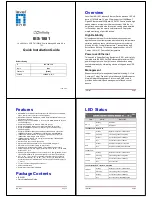
8
ExtremeSwitching SLX 9140 Hardware Installation Guide
9036857-00 Rev AA
Facility requirements
Facility requirements
To install and operate the device successfully, ensure compliance with the following facility requirements.
Electrical considerations
For successful installation and operation of the device, ensure that the following electrical requirements are met:
•
The primary outlet is correctly wired, protected by a circuit breaker, and grounded in accordance with local electrical codes.
•
The supply circuit, line fusing, and wire size are adequate, as specified by the electrical rating on the device nameplate.
•
The power supply standards are met.
Environmental considerations
For successful installation and operation of the device, ensure that the following environmental requirements are met:
•
Because the SLX 9140 switch can be ordered with fans that move air either front to back or back to front, be sure to orient your
switch with the airflow pattern of any other devices in the rack. All equipment in the rack should force air in the same direction to
avoid intake of exhaust air.
•
Some combinations of intake and exhaust airflows may not be compatible with your environment. Consult your fan assembly
and power supply module FRU kits to determine the correct configuration.
•
The ambient air temperature does not exceed 50°C (122°F) while the switch is operating with front-to-back airflow, or 45°C
(113°F) while the switch is operating with back-to-front airflow.
Location considerations
Before installing the device, plan its location and orientation relative to other devices and equipment. Devices can be mounted in a
standard 19-inch equipment rack.
The site should meet the following requirements:
•
Maintain the operating environment as specified in
“Environmental considerations”
•
Allow a minimum of 3 in. of space between the front and the back of the device and walls or other obstructions for proper airflow.
•
Allow at least 3 in. of space at the front and back of the device for the twisted-pair, fiber-optic, and power cabling.
•
Allow access space for installing, cabling, and maintaining the devices.
•
Ensure the status LEDs are clearly visible.
•
Allow for twisted-pair cables to be routed away from power lines, fluorescent lighting fixtures, and other sources of electrical
interference, such as radios and transmitters.
DANGER
Laser radiation. Do not view directly with optical instruments. Class 1M laser products.
DANGER
Use only optical transceivers that are qualified by Extreme Networks, Inc. and comply with the FDA Class 1 radiation
performance requirements defined in 21 CFR Subchapter I, and with IEC 825 and EN60825. Optical products that do not
comply with these standards might emit light that is hazardous to the eyes.
















































